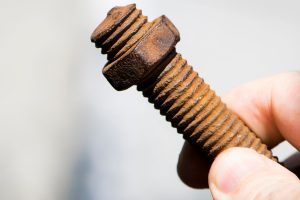
Corrosion is the number one enemy of metal fasteners: a real threat to their integrity and durability and, consequently, to the safety of every project. Let’s take a look at what it is, the different types of corrosion, and strategies to prevent it.
Fastener corrosion: causes and different types of corrosion
By definition, corrosion is a chemical phenomenon that causes the gradual deterioration by external agents of a solid substance, mostly a metal. During corrosion, two types of reaction occur simultaneously:
- oxidation, in which the metal loses one or more electrons, oxidizing itself;
- reduction, in which the reducing element gains one or more electrons, forming hydroxides that produce rust in ferrous materials.
For energy reasons, electrons cannot exist in a free state: in order for a chemical species to oxidize, there must be another that can be reduced at the same time. Hence the modern name oxidation-reduction (REDOX).
Any metal product can be subject to corrosion over time. Nautical and marine applications are the most at risk from corrosion, given the highly alkaline environment and exposure to salt water and humidity.
Other external factors that accelerate corrosion processes are solvents, acids, oils, gases, detergents, high temperatures, and all pollutants that might be found in any working environment.
Among the many types of corrosion, it is important to distinguish direct chemical corrosion from electrochemical corrosion. The former occurs when the fastener material is attacked by chemicals that corrode it. Conversely, the second is generated by the passage of electric current flows through the fastener.
Depending on the cause, we will have different types of electrochemical corrosion.
Galvanic corrosion
It is the wet corrosion process that arises when two metals with different reduction potentials in contact with each other are immersed in a conductive liquid that generates the triggering of galvanic flow, hence the transfer of electrons from one material to the other (Oxidation/Redox effect).
Luigi Galvani was the first to study this phenomenon, with a series of experiments conducted around 1780. The mechanism is simple: when the two metals come into contact with water, which is an electrolyte, an electric current is generated between them. This galvanic flow starts to degrade the less noble metal, i.e. the one with the lowest reduction potential, corroding it.
To avoid or minimize galvanic corrosion, it is essential to carefully choose materials and fasteners: for example, aluminum alloys should never be coupled directly with materials with high carbon content.
Stress corrosion cracking
This process affects parts under constant tensile stress in a corrosive environment or at elevated temperatures. Excessive tension on the fastener makes it more susceptible to damage and can lead to sudden and unexpected failure. Preventing stress corrosion cracking requires constant inspection and maintenance to avoid unpleasant failures.
Crevice corrosion
This type of corrosion occurs in the cracks of an inadequately ventilated fastener, for example at the junctions of metal parts and between metal parts and seals, where dirt or moisture accumulates. It is one of the most dangerous types of corrosion, as it is often detected only after the damage has already occurred.
Uniform and generalized corrosion
This type of corrosion gets its name from the fact that it uniformly affects the entire surface of the material. In the case of fasteners, it can be caused by coating defects.
Honeycomb corrosion
Also called pitting, this type of corrosion leads to the formation of microscopic holes on the surface of the material. It occurs only on particular metals (iron, nickel, aluminum, zinc, copper, brass alloys, and low-grade stainless steels) subjected to certain environmental conditions.
The corrosion process is triggered when the material is present in solutions that contain specific ions, such as halides and perchlorates, for example, seawater. To the naked eye, this type of corrosion is not very visible on the surface of the material, making it all the more difficult to detect.
Prevention: the best defense against corrosion
The prevention of corrosion begins at the product design stage, through the study of environmental conditions and the specific application for which the fasteners will be used.
As mentioned earlier, at the design stage it is vital to choose and use the most suitable materials, surface treatments, and coatings for the final application of the fastener, paying particular attention to possible risks of galvanic corrosion caused by metal incompatibility.
Finally, fasteners must be stored properly in moisture-free environments, and of course to be installed according to the data sheets and instructions of our specialized technicians.
Our sales assistance team ensures timely and attentive support for the selection and purchase of products, including through on-site inspections at the customer’s premises. In this way, we can assess the specifics of each application and recommend the most suitable solutions to prevent corrosion and ensure proper fastening.




